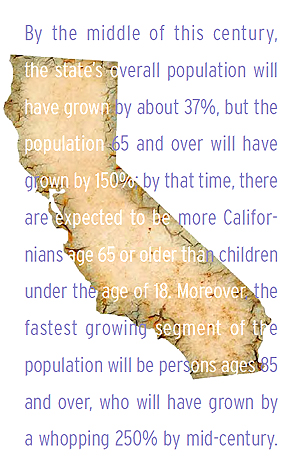
California’s elderly also are becoming more racially and ethnically diverse. Within the next 30 years, the majority of California seniors will be Latino, African American, Asian, or Pacific Islanders, with Latino, Asian, and Pacific Island elderly growing at approximately four times the pace of White non-Hispanics.
The aging of the population is being felt especially by California’s more rural cities and counties. Already, nearly one-fifth of the populations of Lake, Inyo, and Tuolomne counties are age 65 or older, and nearly one half of the populations of Calaveras, Trinity, and Plumas counties are age 50 or older.
Yet, there is little evidence that California’s built environment is prepared for this “silver tsunami.” Indeed, most of California’s houses, neighborhoods, and communities are ill suited for aging bodies and minds. Housing stock seems designed for Peter Pan—someone who will never grow old. Land-use policies and zoning regulations isolate older adults from the services they need. In a state where driving is iconic of independence and freedom, it is not surprising that most streets and transportation systems seem designed to promote “the safety, convenience, and comfort of motor vehicles”—as the U.S. Department of Transportation puts it—rather than assuring that everyone, especially the least mobile among us, can get where they want to go when they want and need to do so. Automobiles are essential for virtually everything—whether getting to the store, seeing a doctor, or visiting friends. “Big-box” stores and giant malls require a substantial amount of walking and negotiating passageways not designed for an older body moving at slow speeds. Seldom does one find even a bench to sit on, let alone a quiet place for friends and neighbors to gather. Even ADA accommodations are designed primarily for younger disabled adults using self-propelled wheelchairs, rather than slow-moving older persons with multiple chronic impairments.
Design for an aging California requires that we view the built environment through eyes that may be older than our own. What do most older adults want? Simply put, they want to reside in private spaces that support their physical, psychological, social, cultural, and spiritual wellbeing, and they want to be able to get to public spaces that do the same.
Like others, they want the option of continuing to live in their familiar homes and apartments, rather than being forced to move simply because they are experiencing the expectable personal changes that come with age. They also want to have the option of staying in familiar neighborhoods and communities, rather than having to relocate and thereby lose the social capital that has accrued over a lifetime of social interactions and interpersonal connections.
What are the characteristics of “aging-friendly” design?
“Aging-friendly” design incorporates physical, social, and technological infrastructures to enhance older adults’ ability to respond to five basic challenges of later life:
- To continue those activities and relationships that have previously been meaningful;
- To compensate for age-related disabilities that limit one’s capacity for physical, psychological, social, cultural, and spiritual fulfillment;
- To have opportunities for connection and meaningful interpersonal relationships;
- To make meaningful contributions to the well-being of others;
- To have opportunities for challenging, enlivening, growth-producing experiences.
In an “aging-friendly” community, services and programs exist to assure that older adults’ basic health and service needs are met, housing stock and transportation infrastructure enable individuals to overcome potential barriers to independent mobility and social interaction, and there are ample opportunities for older adults to develop new sources of fulfillment, productive engagement, and social interaction.
In recent years, a movement of sorts has begun to emerge, a growing recognition that our cities and towns need to become more “aging-friendly.” In California, a number of communities are developing innovative initiatives to prepare for the aging of their citizens, designed to transform local communities to be “good places to grow old,” whether through carefully-designed new development, rehabilitation of existing housing stock, zoning changes designed to integrate commercial and residential land use, integrated transportation systems, or centralized planning efforts that include multiple stakeholders including senior citizens themselves. Assisting them are information and assistance from a growing number of important resources such as AARP, National Association of Area Agencies on Aging, the Robert Wood Johnson Foundation, the California Center for Civic Partnerships, and the Creating Aging-Friendly Communities website, www.agingfriendly.org.
This issue of arcCA is an important next step in helping to design a future for California that reflects the needs of all of us, young and old alike.
Author Andrew E. Scharlach, PhD, is Associate Dean and Professor of Social Welfare at the University of California at Berkeley, where he holds the Eugene and Rose Kleiner Chair in Aging and directs the Gerontology specialization in the School of Social Welfare. He also serves as Director of the Center for the Advanced Study of Aging Services, which conducts research designed to inform development of innovative and effective services for older adults. In addition, Professor Scharlach serves as a gubernatorial appointee on the California Commission on Aging.
Originally published 2nd quarter 2009, in arcCA 09.2, “Design for Aging.”





